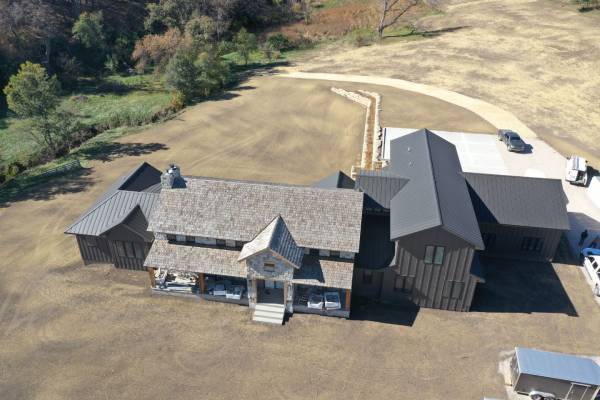A well-built roof keeps a home safe from harsh weather while improving its overall look. Choosing between a pitched roof vs. flat roof depends on structure, durability, cost, and maintenance.
Homeowners must weigh these factors to find the best option for their needs. Each roof type offers benefits and drawbacks. This makes the decision important for long-term performance and comfort.
Explore the key differences to determine the right choice.
Structural Differences
A pitched roof slopes at an angle–forming a peak that directs water and debris away. Its design includes rafters, trusses, or beams that create a strong support system.
This structure helps distribute weight evenly and reduces the risk of collapse under heavy snow or rain. Attic space is another advantage, allowing for insulation, ventilation, or extra storage.
A flat roof appears level but has a slight slope for drainage. Built with layers of membranes, insulation, and a strong base, it comes with a modern look. The design supports rooftop HVAC systems, solar panels, or outdoor living spaces. Though it requires fewer materials than a pitched roof, reinforcement is needed to handle heavy loads.
Durability and Lifespan
A pitched roof lasts longer due to its sloped design, which prevents water pooling. Common materials like asphalt shingles, metal, or tile withstand years of exposure with minimal wear. Proper maintenance extends lifespan and keeps structural integrity intact.
A flat roof may need replacement sooner since water drainage is slower. Materials such as rubber, PVC, or modified bitumen resist moisture but degrade over time. Regular inspections and sealing help prevent leaks. Extra layers or coatings improve longevity. However, the surface remains more vulnerable to weathering.
Weather Resistance in Dickinson County Climate
Strong winds, snow, and storms make roof strength a priority in Dickinson County. A pitched roof handles these conditions well, shedding snow and rain quickly. The sloped surface prevents moisture buildup and reduces the risk of leaks or structural damage.
A flat roof faces more weather-related stress, as standing water may lead to leaks or mold growth. Snow accumulation adds weight, increasing strain on the structure. Reinforced materials and drainage systems help manage these issues. However, more upkeep is necessary to prevent weather-related damage.
Maintenance Requirements
A pitched roof requires fewer repairs since water naturally runs off its surface. Shingle replacement or gutter cleaning keeps it in good condition. Regular inspections catch minor issues before they turn into costly repairs.
A flat roof needs frequent maintenance to avoid pooling water and membrane deterioration. Checking for cracks, leaks, or debris buildup assures longevity. Resealing and applying protective coatings extend its life. Nevertheless, ongoing care is necessary to prevent damage.
Energy Efficiency and Insulation Performance
A pitched roof provides better insulation by allowing space for proper ventilation and thermal barriers. Attics help regulate indoor temperatures and reduce heating and cooling costs. The slope prevents heat buildup in summer and retains warmth in winter.
A flat roof absorbs more sunlight, increasing indoor temperatures during hot months. Additional insulation layers improve energy efficiency. However, cooling costs may rise. Reflective coatings or green roofing solutions help manage heat absorption and deliver better climate control.
Cost Comparison for Installation and Repairs
A pitched roof costs more due to its complex structure and materials. Labor expenses increase since installation requires additional framing and support. Long-term savings come from lower maintenance needs and a longer lifespan.
A flat roof has a lower upfront cost since it uses fewer materials and requires simpler construction. On the other hand, repair and maintenance costs add up over time. Frequent inspections and waterproofing treatments keep it functional but demand ongoing investment.
Design and Aesthetic Appeal for Homeowners
A pitched roof fits traditional and modern homes. It adds character and curb appeal. The slope allows for dormers, skylights, and architectural details that enhance appearance. Various material options make customization easier to match a home’s style.
A flat roof offers a sleek, contemporary look suited for modern architecture. Its clean lines complement commercial buildings and minimalist designs. Rooftop gardens or patios maximize space. Therefore, it’s a practical choice for those seeking functional outdoor areas.
Pitched Roof vs. Flat Roof: Choosing the Best Roof for Your Needs
Homeowners must consider budget, maintenance, and climate when selecting a roof. A pitched roof offers long-term durability, weather resistance, and traditional appeal. Its higher upfront cost pays off through lower maintenance and longer lifespan.
A flat roof provides modern aesthetics, cost-effective installation, and additional usable space. However, more frequent maintenance and water drainage concerns require careful planning. Evaluating priorities helps make an informed decision that balances function and style.
Hire the Best – Top-Rated Roofing Company in Sioux Falls
A strong, reliable roof protects against harsh weather while improving the look of any property. Choosing quality roofing services for homeowners assures durability and long-term value. Our team replaces worn-out roofs, installs new systems, and handles repairs with precision to keep homes safe.
Working with a top-rated roofing company in Sioux Falls guarantees expert craftsmanship, efficient service, and top materials. We focus on getting every project done quickly and within budget without cutting corners. Harveys Five Star Roofing delivers lasting results for both residential and commercial properties.
Call today for a consultation and get the best roofing solutions for your needs.









